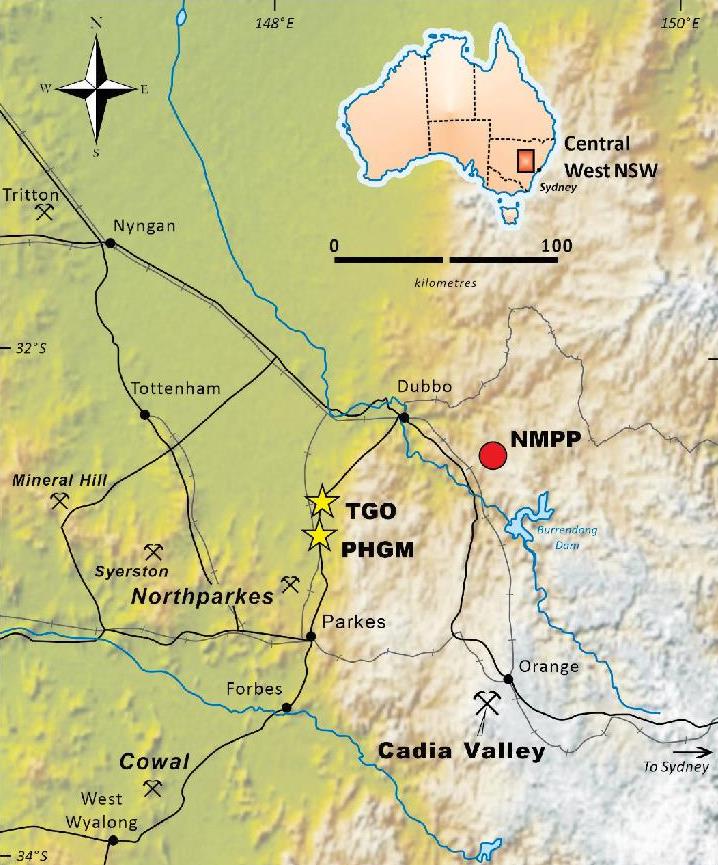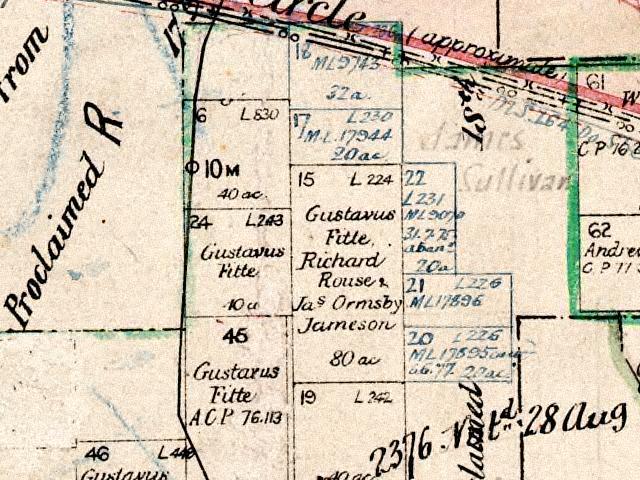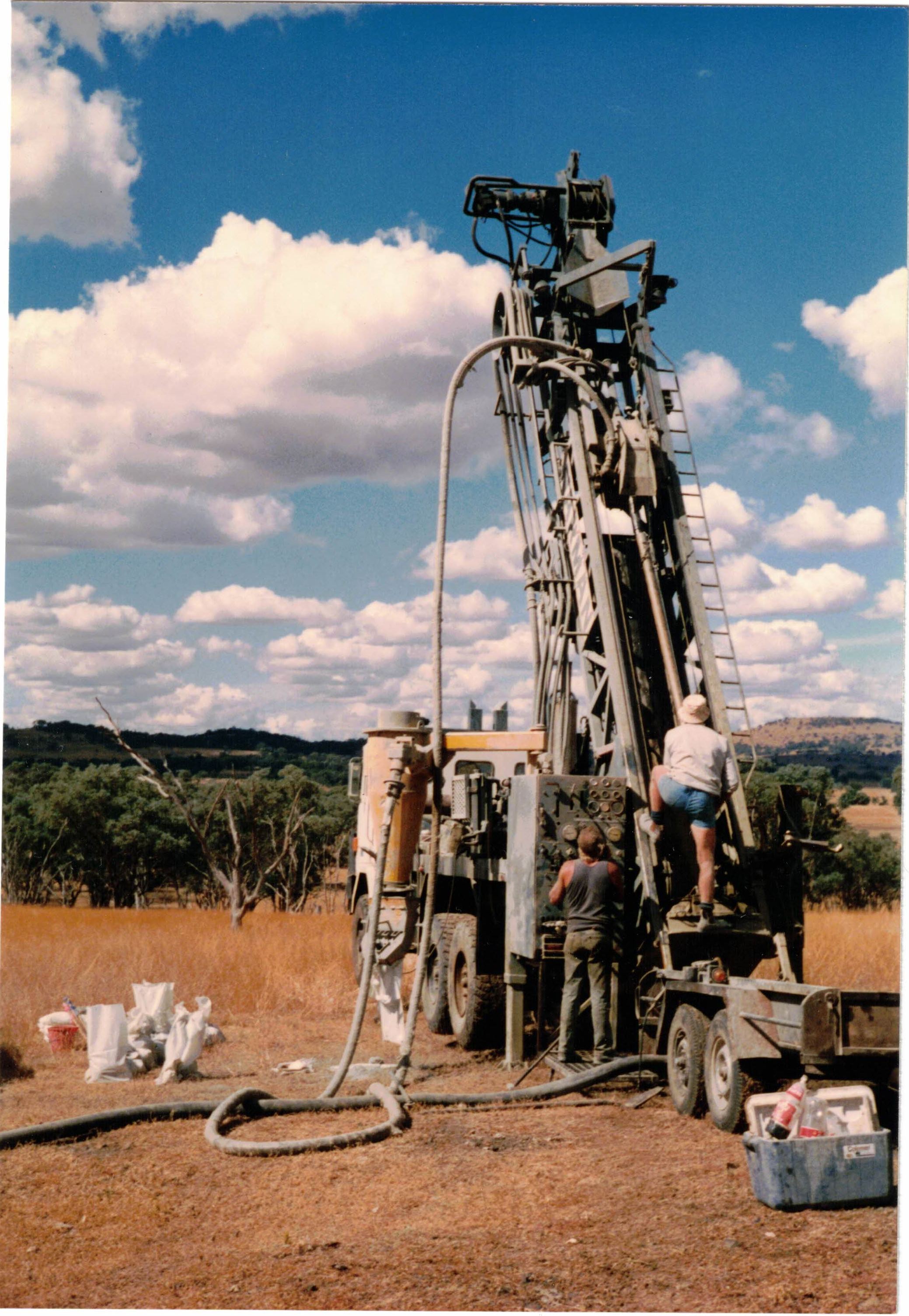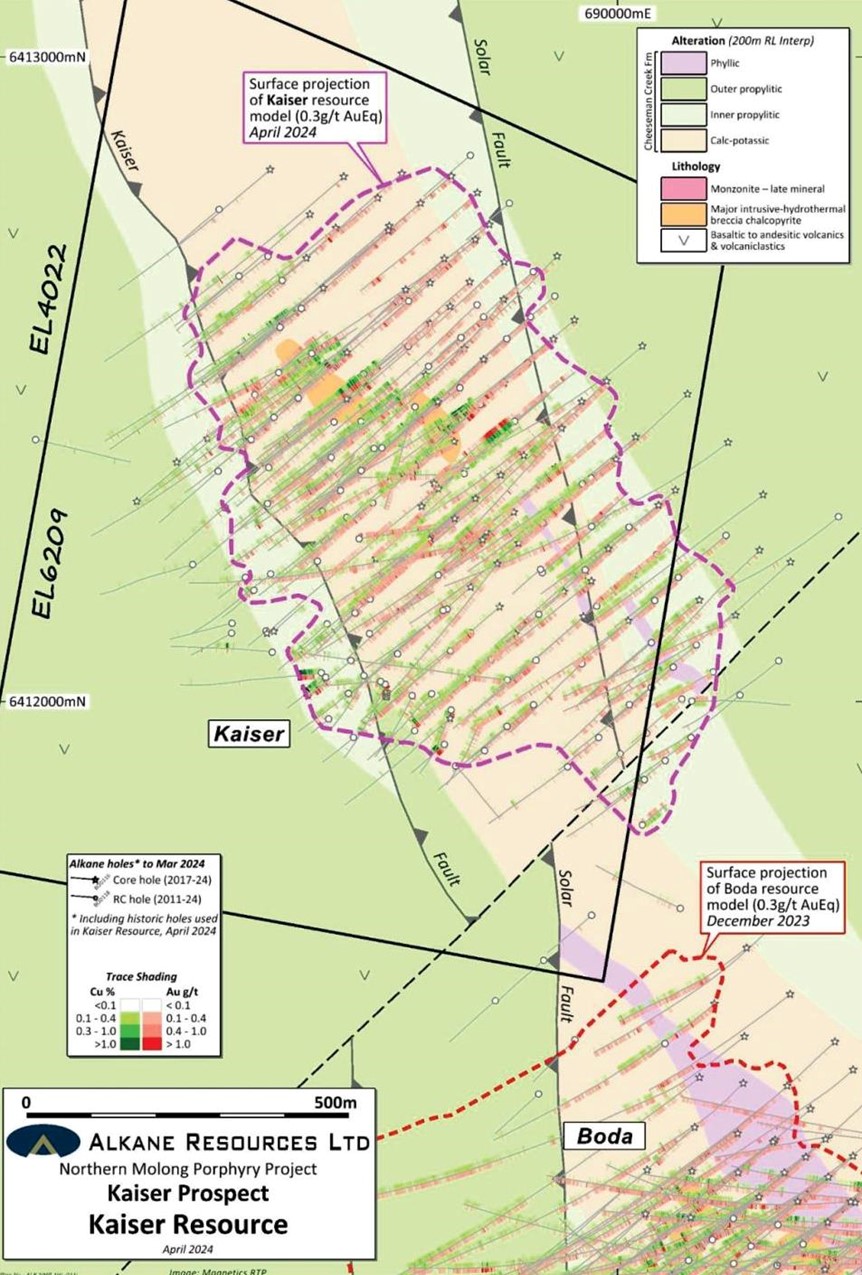Kaiser Deposit

NMPP Location Map (Source: Alkane Resources Ltd.)
The Kaiser and adjacent Boda gold and copper Deposits are located 15 kilometres north of Wellington in central western New South Wales. The Kaiser Deposit is entirely within EL6209, and it is 500 metres northwest from the Boda Deposit in EL4022. Both licences are held by Alkane and are part of its North Molong Porphyry Project (NMPP).
Early Mining
Low Hill of Kaiser, looking NW, 2004 (Source: Boyd Pratt)
In 1872, two local shepherds brought colourful samples of rock to Gustavus Fitte, a Prussian immigrant and the manager of the Mitchells Creek Gold Mine at Bodangora. He recognised that the samples were stained by secondary copper minerals, and he found that they contained gold. They came from a low hill near Bodangora. Subsequently, Gustavus Fitte discovered the wide oxidised lode of what was to become the Kaiser gold mine, the Kaiser prospect and later the Kaiser Deposit.
In 1872 and 1873, Gustavus Fitte applied for mining tenements for what he named the Kaiser mine after the newly created Emperor of Germany. He formed the Kaiser Company, with Richard Rous and James Jamieson. They recognised that the lode was very large and that the copper and gold grades were low. The company opened the lode by several shallow shafts and a small open cut.

Kaiser Tenement Map, 1882 (Source: Parish of Tenandra, County of Lincoln)
In 1876, the company purchased a large, modern, ore treatment plant which it erected beside the nearby Mitchell Creek. However, the gold recovery was too low and by 1880 the mine had closed. It was reported to have recovered more than 1,000 ounces of gold at an average grade of about 15 grams per tonne (g/t). The total ore treated was greater than the approximately 3,000 tonnes of tailings that remain at the old plant site.
Kaiser Copper Precipitation Plant, 1930-31 (Source: Boyd Pratt)
After the first mining operation failed, Gustavus Fitte and others continued to prospect the Kaiser lode. During the period 1904 to 1907, the Kaiser Gold Mining Company made an unsuccessful attempt to raise public funds to re-commence mining operations. Another attempt was made in 1912 but by 1915 prospecting activity had ceased. In 1930 and 1931, the Central Australian Gold Exploration Co. Ltd. built a small, copper precipitation plant at the old mine site. It was unsuccessful and this was the last attempt to mine the Kaiser prospect.
Modern Exploration

Kaiser Drilling, Ajax and Compass, 1988 (Source: Boyd Pratt)
In 1966, Sydney stockbroker and mining tenement speculator Ronald Walton was granted two mining tenements over the old Kaiser gold mine and the surrounding area. The current EL6209 is the successor of those tenements. Modern mineral exploration was commenced with a drilling program by Pacific, in 1965. In 1967, the company estimated that the mine contained a mineral resource of 240,000 tons with 1.11% copper, without an estimate of the gold content.
Between 1988 and 2013, Ajax and five of its exploration partners carried out shallow and some deeper drilling programs. In 1988, Ajax and Compass estimated that the Kaiser mine contained a resource of 270,000 tonnes with 1.5g/t gold and 1.1% copper. Between1993 and 1999, CRA was the first to explore the wider Kaiser prospect for a large, low-grade, porphyry-style deposit.
In 1997, Ajax concluded that the known, shallow, low-grade gold and copper porphyry mineralisation was unlikely to be viable and that exploration should be directed towards the discovery of a deep, higher-grade deposit like the large, blind Cadia Ridgeway deposit of Newcrest, near Orange. In 2008, Ajax estimated that the Kaiser mine contained an inferred resource of 403,000 tonnes with 0.74g/t gold and 0.99% copper.
Recent Exploration
Since 2014, Alkane has conducted several drilling programs on the Kaiser and the nearby Boda prospects. Drilling intersected large deposits of similar porphyry copper and gold mineralisation at both prospects. Significant grades and widths of mineralisation were intersected at the Boda prospect in September 2019 and at the Kaiser prospect in March 2021.
In May 2022, Alkane announced that the Boda Deposit contains a maiden, inferred resource of an estimated 624Mt with 0.26g/t gold and 0.14% copper, based on 83 drill holes with 71,431 metres of drilling. This contains an estimated 10.1M gold equivalent ounces. Most of the Boda resource would require underground mining, while the shallower portion is suitable for lower cost open cut mining.

Kaiser Resource Drill Hole Plan, April 2024 (Source: Alkane Resources Ltd.)
In February 2023, Alkane announced that the Kaiser Deposit contains an inferred resource of an estimated 270Mt with 0.24g/t gold and 0.18% copper, based on 130 drill holes with 49,398 metres of drilling. This contains an estimated 4.7M gold equivalent ounces. The Kaiser resource is suitable for relatively low-cost open cut mining. In May 2023, Alkane received the NSW Mineral Council’s Explorer of the Year Award, for the discovery.
In November 2023, Alkane announced the results of metallurgical tests on samples of the Boda and Kaiser resources. For Kaiser, it was estimated that 79.6% of the copper and 70.7% of the gold would be recoverable in a saleable copper concentrate with a grade of 24.3% copper and 23.g/t gold and no penalty elements. A further 3% of the total gold would be recoverable in a gravity concentrate.
In December 2023, Alkane announced that the Boda Deposit contains an increased total indicated plus inferred resource of an estimated 853Mt with 0.31g/t gold and 0.18% copper, based upon 186 drill holes with 145,458 metres of drilling. This contains an estimated 10.9M ounces gold equivalent. Within the total resource, there is an open pit mineable indicated plus inferred resource of an estimated 233Mt with 0.35g/t gold and 0.17% copper, at a cut-off grade of 0.3g/t gold equivalent and to a vertical depth 800 metres. This contains an estimated 4.31Moz gold equivalent ounces.
In April 2024, Alkane announced that the Kaiser Deposit contains an increased total indicated plus inferred resource of an estimated 213Mt with 0.28g/t gold and 0.20% copper, based upon 217 drill holes with 94,779 metres of drilling. This contains an estimated 3.74M ounces gold equivalent. Within the total resource, there is an open pit mineable indicated plus inferred resource of an estimated 189Mt with 0.27g/t gold and 0.19% copper, at a cut-off grade of 0.3g/t gold equivalent and to a vertical depth of 800 metres. This contains an estimated 3.28Moz gold equivalent ounces.
